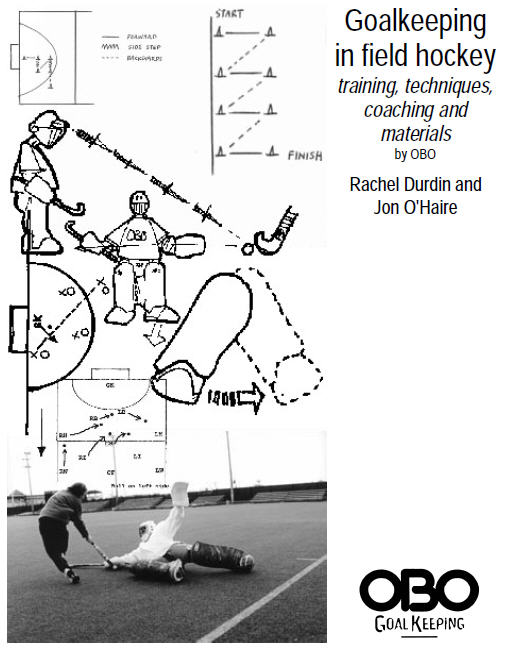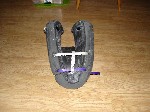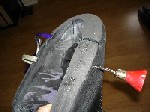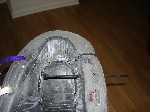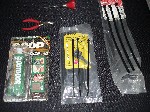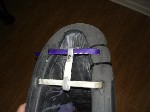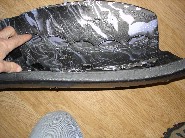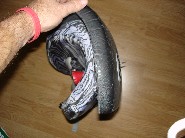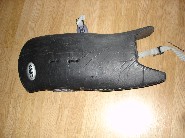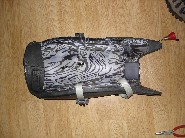There was a day when any lifted shot at goal had to be controlled and cleared by the keeper. Control meant stopping the ball and dropping it straight down to clear. Keepers were required to wear gloves and essentially had to catch the shot without closing their hand on the ball and drop it down. Opposing forwards knew exactly where the first save had to go and were quick to pounce on the dropped shot. If the equipment made the job difficult enough, the consequences of bad technique made the lifted shot brutal. If your save caused the ball to be pushed or deflected you were rewarded with a penalty stroke against you. If you think that was ancient history, those rules were on the books in the 1980's.
There was a day when any lifted shot at goal had to be controlled and cleared by the keeper. Control meant stopping the ball and dropping it straight down to clear. Keepers were required to wear gloves and essentially had to catch the shot without closing their hand on the ball and drop it down. Opposing forwards knew exactly where the first save had to go and were quick to pounce on the dropped shot. If the equipment made the job difficult enough, the consequences of bad technique made the lifted shot brutal. If your save caused the ball to be pushed or deflected you were rewarded with a penalty stroke against you. If you think that was ancient history, those rules were on the books in the 1980’s.
As we’ve moved in to the 21st century, hockey has experienced increased exposure to larger global audiences through television and the spectacle of Olympic Games and World Cups. Marketing research has shown that the new or casual spectator enjoys scoring and hockey has progressively changed the sport to open the flow for offense. Starting with the elimination of offsides, the advent of chip shots, drag flicks, reverse sweeps (or Argentinean backhands) and carbon fiber sticks, scoring and offense ruled the day.
In the interest of safety, the game’s rule-makers have become more sympathetic to the plight of today’s keeper. It started with high density foam and continued with hand protectors and increased latitude in how the keeper can play the aerial shot. This year, the Hockey Rules Board put in to effect a change that can have a significant impact on the position. To better understand the potential of this rule change, let’s take a look at how the rule is worded. The following comes from 2007 FIH Rules for Hockey:
Conduct of Play: Goalkeepers
10.2 When the ball is inside the circle, they are defending and they have their stick in their hand, goalkeepers are permitted to:
A. use their stick, protective equipment or any part of their body to push the ball away, deflect the ball in any direction (including over the back-line) or stop the ball.
This permits a goalkeeper to use their hands, arms or any part of their body to move the ball way, but only as apart of a goal saving action and not to propel the ball forcefully so that it travels a long distance.
Further explanation comes in the Briefings and Guidance to Umpires from the FIH:
Umpires Briefing
Goalkeepers are permitted to move the ball away with their hand/hand protector/arm/body, as part of a goal saving action
This action is permitted in ALL situations where attackers have an opportunity to score or attempt to score a goal, so it can also be used to deny attackers the possibility of possession of the ball or another shot at goal.
There is no requirement that the ball is going towards the goal when using this action, so a goalkeeper may intercept a pass across the face of the goal or sweep the ball away from in front of an attacker’s stick — there only needs to be the threat of an attacker being able to play the ball.
Umpires Guidance
Allow goalkeepers to move the ball away with their hand/hand protector/arm/body, as part of a goal saving action
Permit this action in situations where attackers have an opportunity to score or attempt to score a goal, so it can be used to deny attackers the possibility of possession of the ball or another shot at goal
Be aware that goalkeepers who intentionally propel the ball over a long distance should be penalized with a penalty corner
In the realm of the aerial shot, this rule allows the keeper to bat or propel the shot. Whereas before the keeper could only deflect the ball, he/she can now use a more active skill in playing a shot in to safe areas. Slower paced flicks and difficult knee high shots can now be swatted away with hands or arms as long as they’re kept in the field of play and not over a long-distance. Even the “long distance” wording to the rule gives the keeper an element of flexibility as long as he/she uses common sense in saving the scoring opportunity. An umpire is not going to allow a keeper to propel a medium paced lofted shot 40 meters, but the good news is where as before the punishment was a penalty stroke it’s now a penalty corner.
The rule change has an even greater impact on how the grounded keeper can defend goal scoring opportunities. Remember the old days of 2006 and logging on corners. The keeper would lie down on the corner and the striker would hit a moderately paced shot right at his/her midsection. The initial shot wasn’t a threat to score. The real scoring opportunity came as the keeper was helpless to clear the ball off his/her body and had to rely on teammates to get to the rebound before some forward came crashing in to smash the ball in to the keeper in a “best case situation.” Today the keeper can sweep that rebound to safety with his/her left hand.
The Umpire’s Briefing makes it very clear that the keeper can propel the ball away in any goal scoring opportunity and that goal scoring opportunities are not limited to shots on goal. Think about another situation from last year. You have a one on one with a forward, he pulls to his right and you make a great reverse stick tackle. The ball is a half a meter away from your left hand, but you can’t do a thing because you can’t reach it with your stick and last year’s rules prohibit you from pushing the rebound away with your arms or left hand. The ball is collected and deposited in to your goal. Now you can push it out of harm’s way with your left arm/hand.
Goal mouth passes outside the keeper’s left foot used to present a similar problem. The keeper may have intercepted the pass diving hand first to his/her left, but he/she wasn’t out of danger until the ball was cleared. Now the keeper can push/parry the ball away from the opponent.
These same rules and privileges for the keeper apply to indoor hockey with the difference being that the keeper can not raise the ball when propelling it.
I’ll admit as keeper who has played through the “good old days” there’s a part of me that wants younger keepers to appreciate the older skills and experience the pressure that those situations required. Perspective tells me that doesn’t have to be the case. As a coach and an advocate of the position, I see a far greater benefit to the rule change. As Richard Aggiss of the rules board noted when discussing the change, “We don’t want to make life too easy for goalkeepers but we also don’t want to restrict them in petty ways.” Field hockey is a fast, athletic game and from a player and spectator’s vantage point it’s exciting to see and imagine the ways goals can be scored. With this new rule change it’s equally exciting to imagine the way goal scoring opportunities can be saved.
Good luck,
Jon
e-mail Jon
Please note that OBO together with Jon O’Haire hold copyright over any material appearing on tips pages. We welcome the printing and distribution of these tips, provided that they are not sold, or used for financial gain. This paragraph must appear on all printed or distributed copies. The photographs above must not be used in any form without express permission from Jon O’Haire.
